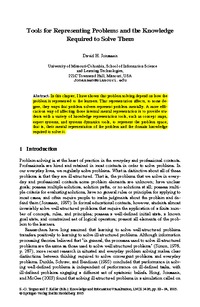Tools for Representing Problems and the Knowledge Required to Solve ThemZu finden in: Knowledge and Information Visualization (Seite 82 bis 94), 2005
|
 |
 Diese Seite wurde seit 9 Jahren inhaltlich nicht mehr aktualisiert.
Unter Umständen ist sie nicht mehr aktuell.
Diese Seite wurde seit 9 Jahren inhaltlich nicht mehr aktualisiert.
Unter Umständen ist sie nicht mehr aktuell.
 Zusammenfassungen
Zusammenfassungen
 In this chapter, I have shown that problem solving depend on how the problem is represented to the learners. That representation affects, to some degree, they ways that problem solvers represent problem mentally. A more efficacious way of affecting those internal mental representation is to provide students with a variety of knowledge representation tools, such as concept maps, expert systems, and systems dynamics tools, to represent the problem space, that is, their mental representation of the problem and the domain knowledge required to solve it.
In this chapter, I have shown that problem solving depend on how the problem is represented to the learners. That representation affects, to some degree, they ways that problem solvers represent problem mentally. A more efficacious way of affecting those internal mental representation is to provide students with a variety of knowledge representation tools, such as concept maps, expert systems, and systems dynamics tools, to represent the problem space, that is, their mental representation of the problem and the domain knowledge required to solve it. The focus of David Jonassen’s paper - titled "Tools for representing problems and knowledge required to solve them" - is on cognitive tools, which may be used to help learners in solving ill-structured problems and to transfer knowledge to different problems. According to Jonassen, problem solving may be fostered when both the relation between information that is inherent in a problem statement and the knowledge needed to make sense of it, is made explicit by using problem representations. The author distinguishes three types of problem representations: semantic network tools (concept maps), production rule models for representing procedural knowledge, and system modeling tools. The problem representation tools share a common characteristic: they simultaneously represent the information inherent in the problem and the particular background knowledge needed for applying a problem solving procedure appropriately.
The focus of David Jonassen’s paper - titled "Tools for representing problems and knowledge required to solve them" - is on cognitive tools, which may be used to help learners in solving ill-structured problems and to transfer knowledge to different problems. According to Jonassen, problem solving may be fostered when both the relation between information that is inherent in a problem statement and the knowledge needed to make sense of it, is made explicit by using problem representations. The author distinguishes three types of problem representations: semantic network tools (concept maps), production rule models for representing procedural knowledge, and system modeling tools. The problem representation tools share a common characteristic: they simultaneously represent the information inherent in the problem and the particular background knowledge needed for applying a problem solving procedure appropriately. Bemerkungen
Bemerkungen
 Leider ist die ursprünglich im Biblionetz erfasste URL eines Volltextes seit mehr als sechs Monaten nicht mehr gültig (Fehlermeldung 404) und wurde deshalb gelöscht. Es ist mir nicht bekannt, ob das Dokument unter einer anderen Adresse noch frei auf dem Internet verfügbar ist.
Leider ist die ursprünglich im Biblionetz erfasste URL eines Volltextes seit mehr als sechs Monaten nicht mehr gültig (Fehlermeldung 404) und wurde deshalb gelöscht. Es ist mir nicht bekannt, ob das Dokument unter einer anderen Adresse noch frei auf dem Internet verfügbar ist. Dieser Text erwähnt ...
Dieser Text erwähnt ...
 Personen KB IB clear | Katherine Beissner , David H. Jonassen , Michael Yacci | ||||||||||||||||||||||||||||||||||||
 Begriffe KB IB clear | Concept MapConcept Map
,  Problem Problem problem problem
| ||||||||||||||||||||||||||||||||||||
 Bücher |
|
 Dieser Text erwähnt vermutlich nicht ...
Dieser Text erwähnt vermutlich nicht ... 
 Nicht erwähnte Begriffe | Concept Mapping Software |
 Zitationsgraph
Zitationsgraph
 Zitationsgraph (Beta-Test mit vis.js)
Zitationsgraph (Beta-Test mit vis.js)
 1 Erwähnungen
1 Erwähnungen 
- Computerbasierte Wirkungsnetzmodellierung und -simulation - Analyse und Weiterentwicklung von Funktionen zum Verständnis von Wirkungsnetzen und zur Früherkennung in komplexen Systemen (Matthias Jurgelucks) (2008)
 Anderswo finden
Anderswo finden
 Volltext dieses Dokuments
Volltext dieses Dokuments
 | Tools for Representing Problems and the Knowledge Required to Solve Them: Artikel als Volltext bei Springerlink ( : :  , 205 kByte) , 205 kByte) |
 Anderswo suchen
Anderswo suchen 
 Beat und dieser Text
Beat und dieser Text
Beat war Co-Leiter des ICT-Kompetenzzentrums TOP während er Dieser Text ins Biblionetz aufgenommen hat. Die bisher letzte Bearbeitung erfolgte während seiner Zeit am Institut für Medien und Schule. Beat besitzt kein physisches, aber ein digitales Exemplar. (das er aber aus Urheberrechtsgründen nicht einfach weitergeben darf). Aufgrund der wenigen Einträge im Biblionetz scheint er es nicht wirklich gelesen zu haben. Es gibt bisher auch nur wenige Objekte im Biblionetz, die dieses Werk zitieren.











 Biblionetz-History
Biblionetz-History